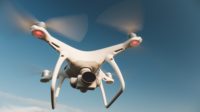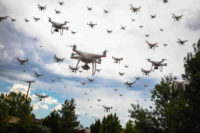Commercial drones & crime prevention through environmental design

It's no secret drones have been and continue to be a key factor in the ongoing technology revolution. Commercial drones in particular are leading the charge. Weighing less than 55 lbs., these drones are available in the consumer market and offer technically mature platforms. Many manufacturers include such functionality as artificial intelligence and autonomous capability, which are now available in military-grade unmanned aerial systems, right off the shelf. Although designed for recreational use, commercial drones can also be employed in ways that pose a threat to public safety.
News accounts of such drone incidents continue to grow daily. Incursions with aircraft are troublesome and quite common, but more disconcerting is the capability for nefarious uses in public space. This technology has created an issue for security professionals in that it explicitly affects security program development and requires prudent measures to address potential threats.
Commercial drones pose not only a threat to an organization's physical security, but, in the hands of a motivated user, can be a cyber threat as well. So, what can be done? Organizations must conduct physical security assessments that include a Drone Vulnerability and Risk Assessment (DVRA). Commercial Drones & Crime Prevention through Environmental Design (CPTED) principles of natural surveillance, access control, territorial reinforcement and maintenance must be included in the technical survey of the physical airspace and the Drone Emergency Response Planning (DERP) to approach security and safety efforts holistically.
CPTED pushes the concept that through proper design and effective use of the built environment, fear and incidence of crime can be reduced or eliminated. The philosophy of CPTED is now considered an important design support tool in a majority of markets. In fact, many cities in the United States and globally now mandate a CPTED review of preliminary design plans for government projects.
Although CPTED is quickly becoming the norm, there is a gap when it comes to commercial drones and emerging technology. CPTED simply hasn’t evolved to consider new technology that will most certainly translate to lasting, impactful effects on society. Commercial drones might provide a chance to rethink CPTED and fill in the gaps.
Granted, CPTED focuses on the natural side of the built environment, but the mechanical aspects are equally important. The design of future public spaces and city modernization programs must now include drone delivery zones and point of launch sites, and thought must be given to building elevations and a future drone superhighway. As city planners and designers start to think about emerging technologies and the future of cities, it becomes clear that commercial drones are here to stay.
Commercial drones and robotics are technologies that will impact this environment. If they are not included in CPTED assessments during the preliminary design phase, modifications must be made later on, creating additional costs to cities and citizens. A CPTED site survey in coordination with a DVRA and DERP is the smart approach when tackling how technology will shape the environment.
Urbanist Jane Jacobs and the other pioneers of CPTED concepts emphasized putting more "eyes on the street" to keep communities safe and vibrant. The concept ensured that normal users of public space would identify threats and, through territorial reinforcement, reduce crime via direct action or reports to local private or public security professionals.
The future super drone highway will operate at heights between 200-400 feet above ground level. Without defined aerial boundaries, drone threats that range from unwanted surveillance to privacy issues and weaponization are sure to take place. CPTED site surveys will provide the needed detailed analysis to supplement DVRAs and greatly assist in developing an effective DERP.
Documents such as the Interagency Security Committee's Protecting Against the Threat of Unmanned Aircraft Systems (UAS): An Interagency Security Committee Best Practice state that federally funded protective measures would be deployed no earlier than 30 days after a request is submitted. This emphasizes the need for facilities to complete a DVRA now and build this technology into their overall security programs.
Architects, urban planners, engineers, security professionals and key stakeholders must address these potential threats early in the design phase. A CPTED review of proposed site plans can identify potential problems at the onset rather than attempting a costly retrofit post-construction. Successful loss prevention strategies include a CPTED site survey review that reduces the probability of criminal acts.
An updated approach to CPTED is a valuable assessment methodology to address emerging and evolving technologies that have an impact on the built environment. Commercial drones are becoming more widely used in public spaces along with the nefarious use of these platforms. We must work together toward modernizing and maturing the CPTED model to address the continuous evolution of technology and its effects on society, thereby creating a safer and more secure environment for all.
Looking for a reprint of this article?
From high-res PDFs to custom plaques, order your copy today!






